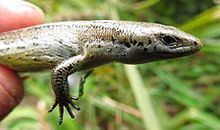Class Reptilia Family Scincidae Rank Species | Phylum Chordata | |
 | ||
Similar | ||
The Te Kakahu skink, Oligosoma tekakahu, is a critically endangered species of skink native to New Zealand. It was discovered in 2002 and described from a specimen found on Chalky Island (Te Kakahu), in Fiordland National Park.
Contents
Appearance
Although very similar to the southern and cryptic skink the Te Kakahu skink is genetically distinct. It is more sturdy than the Cryptic skink and has small black markings on its back. The Te Kakahu skink has a predominantly brown glossy appearance and has a comparatively larger head than other related Oligosoma species. Another distinguishing feature is that it has minimal projecting scales on the interior edge of its ear opening.
Habitat
The Te Kakahu skink is recorded as inhabiting just one 50 metre by 50 metre site of open scrubby terrain on the cliffs along the coast of Chalky Island (Te Kakahu).
Conservation status
In 2012 the Department of Conservation reclassified the Te Kakahu skink as Nationally Critical under the New Zealand Threat Classification System. It was judged as meeting the criteria for Nationally Critical threat status as a result of it occupying a total area of less than 1 hectare. The Te Kakahu skink is considered conservation dependent, in partial decline and found only in one location.
Conservation efforts
In February 2013 Department of Conservation (DOC) staff counted and studied a total of 160 skinks from the Chalky Island site. The Department of Conservation is planning to identify suitable habitat on other predatory free islands. They hope translocate some Te Kakahu skink to help ensure the species survival. A population assessment was undertaken by the Department of Conservation (DOC) on Chalky Island in early 2016. This indicated that a relatively abundant population exists to support a harvest of skinks for translocation.
Etymology
The Te Kakahu skink obtained its species name tekakahu from the Maori name of the locality where it was first discovered.
